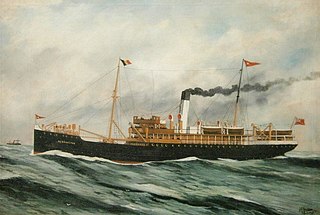
A steamship, often referred to as a steamer, is a type of steam-powered vessel, typically ocean-faring and seaworthy, that is propelled by one or more steam engines that typically move (turn) propellers or paddlewheels. The first steamships came into practical usage during the early 1800s; however, there were exceptions that came before. Steamships usually use the prefix designations of "PS" for paddle steamer or "SS" for screw steamer. As paddle steamers became less common, "SS" is assumed by many to stand for "steamship". Ships powered by internal combustion engines use a prefix such as "MV" for motor vessel, so it is not correct to use "SS" for most modern vessels.
Gourlay Brothers was a marine engineering and shipbuilding company based in Dundee, Scotland. It existed between 1846 and 1908.

This article describes the shipping services of the London and South Western Railway and the vessels employed.

The SS Yarmouth was a steel-hulled steamship owned by the Great Eastern Railway. She was built in 1903 for use on their cargo service between Harwich, Essex, and the Hook of Holland and Rotterdam, the Netherlands. She was lost at sea with all hands on 27 October 1908.
SS Equity was a freight vessel built for the Co-operative Wholesale Society Limited in 1888.
SS Ralph Creyke was a passenger and freight vessel built for the Goole Steam Shipping Company in 1879.
PS Zealous was a passenger vessel built for the Great Eastern Railway in 1864.
PS Lady Tyler was a passenger vessel built for the Great Eastern Railway in 1880.

PS Avalon was an iron paddle passenger vessel built on the River Thames for the Great Eastern Railway in 1864 for their ferry services from Harwich to Rotterdam and Antwerp. Before the end of that year she was bought by British interests to assist with the commissioning of the Confederate iron-clad CSS Stonewall, and renamed City of Richmond. After the war she was renamed Agnes Arkle and sold in Brazil in 1865.
PS Richard Young was a passenger vessel built for the Great Eastern Railway in 1871.

TSS Malines was a passenger vessel built for the Great Eastern Railway in 1921.
PS Harwich was a freight vessel built for the Great Eastern Railway in 1864.
SS Nottingham was a passenger and freight vessel built for the Manchester, Sheffield and Lincolnshire Railway in 1891.

TSS Cromer was a cargo vessel built for the Great Eastern Railway in 1902.

SS Marylebone was a passenger and cargo vessel built for the Great Central Railway in 1906.

SS Accrington was a passenger and cargo vessel built for the Great Central Railway in 1910.

SS Dewsbury was a passenger and cargo vessel built for the Great Central Railway in 1910.
SS Chester was a passenger and cargo vessel built for the Manchester, Sheffield and Lincolnshire Railway in 1884.
The Solent Sea Steam Packet Company, later the Solent Steam Packet Company, operated ferry services between Lymington and Yarmouth on the Isle of Wight between 1841 and 1884.
PS Solent was a passenger vessel built for the London and South Western Railway in 1902.








